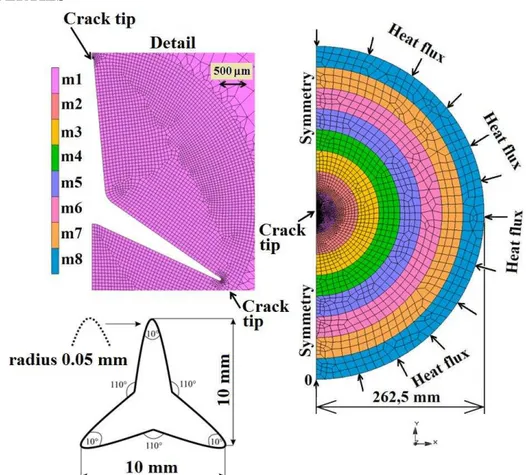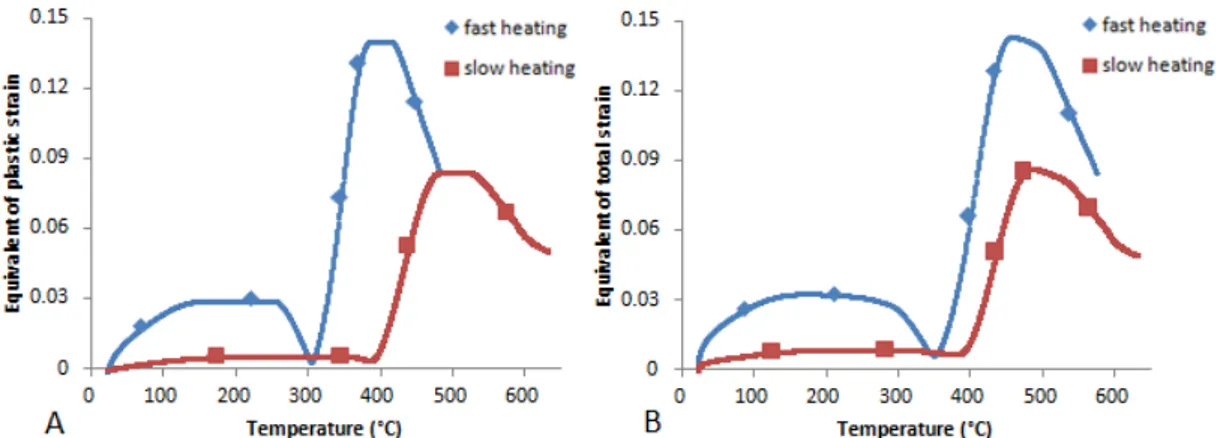39
Transactions of the VŠB – Technical University of Ostrava, Mechanical Series No. 1, 2013, vol. LIX
article No. 1933
Miroslav KVÍČALA*, Karel FRYDRÝŠEK**
FEM SIMULATION OF STRESS-STRAIN FIELDS IN THE BLOOMS WITH CASTING DEFECT DURING SOAKING
MKP SIMULACE NAP ŤOV -DEFORMAČNÍCH POLÍ V KONTISLITKU OBSAHUJÍCÍM LICÍ DEFEKT B HEM OH EVU V HLUBINNÉ PECI
Abstract
Round continuously cast blooms heating strategy is crucial in prevention of internal cracks initiation and propagation. Especially vanadium microalloyed Cr-Mo based steels are very sensitive to internal crack occurrence. This paper deals with two heating strategies that were realized in soaking pit. Using FEM simulation it was proved that proper heating strategy is essential to reduce internal crack propagation.
Abstrakt
Spravná strategie oh evu kruhových kontislitků je zcela klíčová p i prevenci vzniku a ší ení vnit ních defektů. Obzvlášt oceli mikrolegované vanadem jsou velmi náchylné ke vzniku vnit ních licích defektů. Tento článek pojednává o dvou strategiích oh evu, které byly realizovány vhlubinné peci. Za použití MKP bylo dokázáno, že vhodná strategie oh evu je zcela nezbytná, má-li být ší ení trhliny co nejvíce omezeno.
Keywords
Bloom, crack, FEM, soaking, vanadium.
1
INTRODUCTION
In the case of the vanadium microalloyed steels, hot rolling of square billets from round continuously cast blooms with diameter 525 mm is complicated by the fact, that the internal defects are detected during ultrasonic inspection at the end of production process on cooling bed. Final quality of hot rolled billets is influenced especially by casting conditions such as casting speed and steel superheat in a tundish, heating conditions in soaking pit and hot rolling factors [1,2,3,4,5]. Production process is also complicated by the fact that continuously cast blooms may contain internal defect (Fig. 1).
*
M.Sc.&M.Sc., Ph.D., Department of non-ferrous metals,refining and recycling. Faculty of Metallurgy and Material Engineering, VŠB – Technical University of Ostrava, 17. listopadu 15/2172, 708 33 Ostrava, Czech Republic, tel. (+420) 59 732 9387, e-mail: miroslav.kvicala@vsb.cz
**
Fig. 1 Macroetched transverse cut of continuously cast round bloom (diameter 525 mm) – A; transverse cut of hot rolled billet (260x260 mm) from 25CrMo4 steel – B.
In this paper, it is demonstrated that for optimization of heating process in soaking pit before hot rolling it is necessary to respect the thermophysical properties and stress-strain behaviour of vanadium microalloyed steels. Using FEM software MSC.MARC it was demonstrated that proper heating strategy before hot rolling may decrease internal crack grow significantly.
2
FEM SIMULATION BOUNDARY CONDITIONS AND MATERIAL
PROPERTIES
Fig. 2 Transverse half of continuously cast bloom with diameter 525 mm loaded by heat flux. Every group of elements (m1, m2, ..., m8) is represented by specific chemical composition,
mechanical and thermophysical properties. Schematic representation of the defect is also included.
strategies were chosen (first heating consisted from surface heating up to 800 °C during two hours; second heating strategy consists from heating up to Ř00 °C during four hours; starting temperature was 20°C for all heatings Ěthe heat accumulated in the round bloom is exactly the same for both heating strategies).
In our simulations were applied heat fluxes (q = 2,5×104 W/m2 for the heating in four hours and q = 5×104 W/m2 for heating in two hours), for more detailes see [8,9]. Presented FEM model consists from 8 cells, 9136 tetrahedral elements with parabolic borders and 27857 nodes. The time iteration was used for both heating strategies (2,5 s per one calculation step). For practical problem description it is fully correct to use 2D model. 3D model is not necessary because the stress-strain behaviour is stimulated by heat gradient across the transverse cut of continuously cast bloom. Heat gradient in the longitudial direction may be neglected (length of the bloom is roughly 4 meters) with one exception – asymptotic region that is linked to bloom´s corners at both ends Ěthis fact may be responsible for potential surface corner cracks). From the theoretical point of view the most interesting is stress-strain behaviour in the crack surrounding so the different density of elements and nodes was used for cell m1 and remaining cells m2 – m8. FEM network for both two simulations is shown (Fig.2).
Because of known chemical inhomogenity of continuously cast blooms based on experimental procedures [1,3] and calculations in IDS solidification software the yield stress, tensile stress, Young modulus, thermal conductivity, heat capacity and thermal expansivity across the bloom diameter were modified for temperature range 20 – Ř00 °C. Therefore, material dependences across the bloom diameters were approximated by eight cells of materials m1, m2, ... , m8, see (Tab.1) and the same procedure was done for chemical composition (Tab.2)
Tab. 1 Overview of simulated mechanical and thermophysical properties for continuously cast bloom with diameter 525 mm made from 25CrMo4 steel.
Yield stress (MPa) Ultimate stress (MPa)
Modulus of elasticity (MPa)
Thermal conductivity (W.m-1.°C-1)
Specific heat (kJ.kg-1.°C-1)
Coefficient of thermal expansion Ě°C-1
)
Min.: 139 180 8x1010 19.41 0.44 10-5
Max.: 847 1100 2.5x1011 40.1 0.59 2.1x10-5
Tab. 2 Overview of chemical composition for continuously cast bloom with diameter 525 mm made from 25CrMo4 steel.
C Cr Mn Mo V Si Ni S P
Min.: 0.22 1.12 0.7 0.2 0.04 0.2 0.3 0.008 0.008
Max.: 0.35 2.25 1.4 0.7 0.3 0.3 0.1 0.015 0.015
3
RESULTS AND DISCUSSION
Fig. 3A and 4. In case of equivalent of eleastic strain, the most significant difference between slow and fast heating strategy can be observed around 500 °C, see Fig. 3B.
Fig. 3 Temperature dependence of equivalent of stress – A and equivalent of elastic strain - B, in the centre of continuously cast bloom for two heating strategies (2 hours and 4 hours). Model
with internal tricuspid defect was used.
Fig. 4 Equivalent von Mises stresses across the continuously cast bloom during heating in soaking pit (FEM results).
Fig. 5 Temperature dependence of equivalent of plastic strain – A and equivalent of total strain - B, in the centre of continuously cast bloom for two heating strategies (2 hours and 4 hours).
Model with internal tricuspid defect was used.
The equivalent of plastic strain is roughly one order higher than equivalent of elastic strain. Moreover, there are significant differences between slow and fast heating strategies. In case of fastheating strategy, intensive plastic deformation is realized even at relative low soaking temperatures. If the proper heating strategy is used, relative small internal crack can be welded during hot rolling, but combination of casting cracks and suboptimal soaking results in hot rolled billets that have to be rehected after ultrasonic inspection.
4
CONCLUSIONS
FEM simulation of two heating strategies revealed the reason of the massive internal crack grow. Even if the casting conditions are suboptimal it is possible to prevent rapid internal cracks grow during the heating in soaking pit. If the defects grow is limited, proper hot rolling is able to reduce number of internal defects that are identified during ultrasonic inspection. The heating strategy discussed in this paper represents compromise between the blooms quality and production capacity and gas consumption on the other side.
ACKNOWLEDGEMENT
This work was supported by the Czech project FR-TI3/Ř1Ř “External Fixation”, by the Czech -EU project CZ.1.07/2.3.00/30.0016 “Opportunity for young researchers” and by Czech-EU project CZ.1.05/2.1.00/01.0040 “Regional Materials Science and Technology Centre ĚRMSTCě”.
This paper has been elaborated in the framework of the project Opportunity for young researchers, reg. no. CZ.1.07/2.3.00/30.0016, supported by Operational Programme Education for Competitiveness and co-financed by the European Social Fund and the state budget of the Czech Republic.
This paper been supported by Advanced Solutions – supplier of sophisticated statistical analysis and artificial neural networks solutions (www.adsol.cz).
REFERENCES
[1] KVÍČALA, M., HENDRYCH, A., ŽIVOTSKÝ, O. & JANDAČKA, P., The influence of Cr, Mn and Mo elements on cracks occurence in low-alloyed Cr-Mo steels. Acta Metallurgica
Slovaca 2010, Vol. 16, Nr.2, pp. 122-126, ISSN 1338-1156.
[2] KVÍČALA, M., MORÁVKA, J. & JANDAČKA, P.: Influence of continuously cast bloom’s heating strategy on cracks occurence in low-alloyed Cr-Mo based steel 25CrMo4.
[3] KVÍČALA. M., KLIMEK, M. & SCHINDLER I., Study of Technological Formability of Low-Alloyed Steel 25CrMo4. Hutnické listy. 2009, Nr. 6, pp. 13-15, ISSN 0018-8069. [4] MINTZ, B., BARENJEE., J. R. Influence of C and Mn on ductility behaviour of steel and its
relationship to transverse cracking in continuous casting. Materials Science and Technology 2010, Vol. 26, pp. 547 – 551. ISSN 0267-0836.
[5] MINTZ, B., CROWTHER, D. N. Hot ductility of steels and its relation to the problem of transverse cracking in continuous casting. International Materials Reviews 2010, Vol. 55, pp. 168 – 196. ISSN 0950-6608.
[6] FRYDRÝŠEK, K.: Praktikum software MSC.MARC/MENTAT - část 1, Faculty of Mechanical
Engineering, VŠB-Technical University of Ostrava, Ostrava, ISBN 978-80-248-2125-2, Ostrava, 2009, Czech Republic, pp.154.
[7] FRYDRÝŠEK, K., FUSEK, M., HRABEC, J.: Praktikum software MSC.MARC/MENTAT -
část 2, Faculty of Mechanical Engineering, VŠB-Technical University of Ostrava, Ostrava,
ISBN 978-80-248-2211-2, Ostrava, 2010, Czech Republic, pp.144.
[8] KVÍČALA, M.; FRYDRÝŠEK, K.: Simulation of temperature gradients and equivalent stress of low-alloyed Cr-Mo based steel, International Scientific Conference Mechanical Structures
and Foundation Engineering 2010, Ostrava, Czech Republic (2010), p. 36 - 43.
[9] KVÍČALA, M.; FRYDRÝŠEK, K.: Simulation of elastic and plastic deformation behavior of low-alloyed Cr-Mo based steel, International Scientific conference Mechanical Structures and



